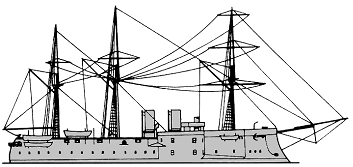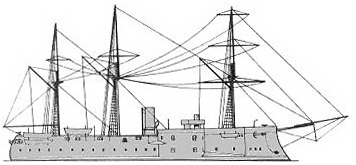
NAVYPEDIA
 Support the project with paypal
Support the project with paypal
Photo

Erzherzog Albrecht 1882
Ships
| Name | No | Yard No | Builder | Laid down | Launched | Comp | Fate |
|---|---|---|---|---|---|---|---|
| Erzherzog Albrecht | STT, Triest | 1.6.1870 | 24.4.1872 | 6/1874 | accommodation hulk 1908 |
Technical data
| Displacement normal, t | 5980 |
|---|---|
| Displacement full, t | |
| Length, m | 89.7 oa 87.9 wl |
| Breadth, m | 17.2 |
| Draught, m | 6.72 |
| No of shafts | 1 |
| Machinery | 1 2-cyl HRCR, 8 rectangular boilers |
| Power, h. p. | 3969 |
| Max speed, kts | 12.8 |
| Fuel, t | coal 500 |
| Endurance, nm(kts) | 2300(10) |
| Armour, mm | wrought iron; belt: 205, casemates: 175 |
| Armament | 8 x 1 - 235/20 G. L/22 C.74, 6 x 1 - 87/22 G. L/24 M.75 |
| Complement | 540 |
Standard scale images

Erzherzog Albrecht 1892

Erzherzog Albrecht 1877
Graphics
Project history
Chief Engineer Romako designed two casemate ships, Custoza and Erzherzog Albrecht - the first iron ships of the Austro-Hungarian Navy - after studying the results of the Battle of Lissa. He arranged the guns at two levels, so that they could bear forward while the ship was speeding up to ram the enemy. His designs emphasised less speed and fewer guns, in favour of high defensive capability.
Ship protection
The belt protected all ship length and extended from 1.2m under wl to 2.4m above. It was 203mm-thick amidships and 120mm at ship ends and was backed by 200mm teak layer. Two-deck casemate (16m long) was connected with upper edge of the belt and was backed by 260mm wood. Lower part was protected by 178mm sides and 127mm transverse bulkheads, upper part by 152mm sides and 127mm fwd and 114mm aft transverse bulkheads.
Modernizations
1880s: + 2 x 1 - 66/16 G. L/18, 4 - 350 TT (1 bow, 2 beam, 1 stern)
1892: + 4 x 1 - 47/30 SFK L/33 H, 5 x 5 - 47/22 SFK L/25 H, 2 x 5 - 25/41 Nordenfeldt; also one funnel was replaced by two
Naval service
Erzherzog Albrecht saw active service from 1874 to 1908. In 1908 she was renamed Feuerspeier and became the tender of the gunnery training ship, and from October 1915 she served as accommodation ship for German naval personnel. In 1920 she was ceded to Italy as war reparation and renamed Buttafuoco.
 HOME
HOME FIGHTING SHIPS OF THE WORLD
FIGHTING SHIPS OF THE WORLD AUSTRIA-HUNGARY
AUSTRIA-HUNGARY CAPITAL SHIPS
CAPITAL SHIPS ERZHERZOG ALBRECHT centre battery ship (1874)
ERZHERZOG ALBRECHT centre battery ship (1874)

